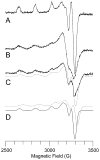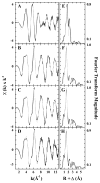Crystal structure and characterization of particulate methane monooxygenase from Methylocystis species strain M
- PMID: 22013879
- PMCID: PMC3364217
- DOI: 10.1021/bi200801z
Crystal structure and characterization of particulate methane monooxygenase from Methylocystis species strain M
Abstract
Particulate methane monooxygenase (pMMO) is an integral membrane metalloenzyme that oxidizes methane to methanol in methanotrophic bacteria. Previous biochemical and structural studies of pMMO have focused on preparations from Methylococcus capsulatus (Bath) and Methylosinus trichosporium OB3b. A pMMO from a third organism, Methylocystis species strain M, has been isolated and characterized. Both membrane-bound and solubilized Methylocystis sp. strain M pMMO contain ~2 copper ions per 100 kDa protomer and exhibit copper-dependent propylene epoxidation activity. Spectroscopic data indicate that Methylocystis sp. strain M pMMO contains a mixture of Cu(I) and Cu(II), of which the latter exhibits two distinct type 2 Cu(II) electron paramagnetic resonance (EPR) signals. Extended X-ray absorption fine structure (EXAFS) data are best fit with a mixture of Cu-O/N and Cu-Cu ligand environments with a Cu-Cu interaction at 2.52-2.64 Å. The crystal structure of Methylocystis sp. strain M pMMO was determined to 2.68 Å resolution and is the best quality pMMO structure obtained to date. It provides a revised model for the pmoA and pmoC subunits and has led to an improved model of M. capsulatus (Bath) pMMO. In these new structures, the intramembrane zinc/copper binding site has a different coordination environment from that in previous models.
Figures






Similar articles
-
The metal centers of particulate methane monooxygenase from Methylosinus trichosporium OB3b.Biochemistry. 2008 Jul 1;47(26):6793-801. doi: 10.1021/bi800598h. Epub 2008 Jun 10. Biochemistry. 2008. PMID: 18540635 Free PMC article.
-
From micelles to bicelles: Effect of the membrane on particulate methane monooxygenase activity.J Biol Chem. 2018 Jul 6;293(27):10457-10465. doi: 10.1074/jbc.RA118.003348. Epub 2018 May 8. J Biol Chem. 2018. PMID: 29739854 Free PMC article.
-
Effect of methanobactin on the activity and electron paramagnetic resonance spectra of the membrane-associated methane monooxygenase in Methylococcus capsulatus Bath.Microbiology (Reading). 2005 Oct;151(Pt 10):3417-3426. doi: 10.1099/mic.0.28169-0. Microbiology (Reading). 2005. PMID: 16207923
-
Copper-dioxygen complex mediated C-H bond oxygenation: relevance for particulate methane monooxygenase (pMMO).Curr Opin Chem Biol. 2009 Feb;13(1):119-31. doi: 10.1016/j.cbpa.2009.02.025. Epub 2009 Mar 13. Curr Opin Chem Biol. 2009. PMID: 19286415 Free PMC article. Review.
-
Architecture and active site of particulate methane monooxygenase.Crit Rev Biochem Mol Biol. 2012 Nov-Dec;47(6):483-92. doi: 10.3109/10409238.2012.697865. Epub 2012 Jun 23. Crit Rev Biochem Mol Biol. 2012. PMID: 22725967 Free PMC article. Review.
Cited by
-
Evidence for oxygen binding at the active site of particulate methane monooxygenase.J Am Chem Soc. 2012 May 9;134(18):7640-3. doi: 10.1021/ja302195p. Epub 2012 May 1. J Am Chem Soc. 2012. PMID: 22540911 Free PMC article.
-
Structural conservation of the B subunit in the ammonia monooxygenase/particulate methane monooxygenase superfamily.Proteins. 2014 Sep;82(9):2263-7. doi: 10.1002/prot.24535. Epub 2014 Mar 20. Proteins. 2014. PMID: 24523098 Free PMC article.
-
Enzymatic oxidation of methane.Biochemistry. 2015 Apr 14;54(14):2283-94. doi: 10.1021/acs.biochem.5b00198. Epub 2015 Apr 1. Biochemistry. 2015. PMID: 25806595 Free PMC article. Review.
-
Copper active sites in biology.Chem Rev. 2014 Apr 9;114(7):3659-853. doi: 10.1021/cr400327t. Epub 2014 Mar 3. Chem Rev. 2014. PMID: 24588098 Free PMC article. Review. No abstract available.
-
Product analog binding identifies the copper active site of particulate methane monooxygenase.Nat Catal. 2023 Dec;6(12):1194-1204. doi: 10.1038/s41929-023-01051-x. Epub 2023 Nov 6. Nat Catal. 2023. PMID: 38187819 Free PMC article.
References
-
- Hakemian AS, Rosenzweig AC. The biochemistry of methane oxidation. Annu Rev Biochem. 2007;76:223–241. - PubMed
-
- Rosenzweig AC, Frederick CA, Lippard SJ, Nordlund P. Crystal structure of a bacterial non-haem iron hydroxylase that catalyses the biological oxidation of methane. Nature. 1993;366:537–543. - PubMed
-
- Merkx M, Kopp DA, Sazinsky MH, Blazyk JL, Müller J, Lippard SJ. Dioxygen activation and methane hydroxylation by soluble methane monooxygenase: a tale of two irons and three proteins. Angew Chem, Int Ed. 2001;40:2782–2807. - PubMed
Publication types
MeSH terms
Substances
Associated data
- Actions
- Actions
Grants and funding
LinkOut - more resources
Full Text Sources
Other Literature Sources
Molecular Biology Databases
Research Materials

